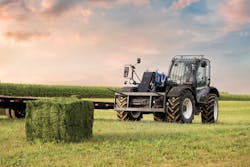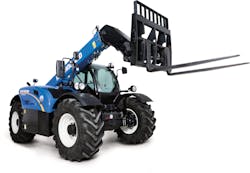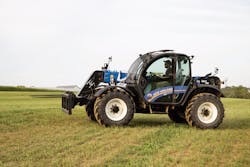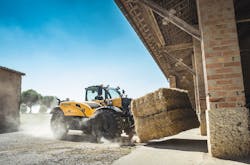Electrohydraulics Benefit Tool Leveling for Telehandlers
In an effort to help improve telehandler operation, New Holland Agriculture has developed an Electro-Hydraulic Self Leveling Tool Carrier system. Moving from the traditional mechanical system which has become industry standard to an electrohydraulic alternative provides the opportunity to improve attachment leveling and reduce operator input, among other benefits.
This was achieved through the incorporation of angle sensors and communication with onboard electronics, enabling more precise movement and leveling of attachments.
A Transition from Purely Mechanical Systems
Traditionally, telehandlers equipped with attachments such as buckets or forks utilize a system based on hydraulic compensation to keep the tool parallel to the ground when lifting or lowering the machine’s boom. As the boom moves, oil flows from a compensation cylinder to a tilt cylinder to maintain the attachment’s position.
Mark Howell, New Holland Global Product Manager Alternative Fuels & Telehandlers, said in an interview with Power & Motion that this is an industry standard method employed since telehandlers entered the market. However, it was developed when everything was mechanical which is not the case today.
Like many machines, New Holland’s telehandlers now feature more electronics. For instance, electrohydraulic valves are used for controlling telehandler attachments and electronic joysticks have become the norm in operator cabs. And the company continues to look for ways to further improve its machine designs.
READ MORE: Getting the Most out of Electrohydraulic Valves
“We've been asking for more advanced features for the vehicle and having a mechanical compensation valve limits some of the ideas that we had,” said Howell.
To achieve these advanced features, it was determined there could be benefits to removing the telehandler’s compensation cylinder. Instead, two angle sensors are attached to the boom to aid with attachment leveling:
- one at the rear to monitor boom angle relative to the machine
- one at the front, on the tool carrier, to monitor its angle in relation to the boom.
Incorporation of the sensors enables real-time position information of the boom to be determined as it is raised and lowered. This information is provided to the telehandler’s ECU (electronic control unit) where software uses it to calculate the hydraulic flow needed to maintain a level position of the attachment.
Electronics Aid Ease of Use
With the telehandler’s onboard electronics, attachments can be kept at a level position without much effort from an operator. “What would happen normally is the driver would be lifting the boom and then, without being conscious about it, gently nudge the joystick to maintain the level [of the attachment],” said Howell.
Removing the need for operators to level the attachment themselves allows them to stay better focused on the work in front of them while also improving their comfort.
This capability is particularly beneficial for operators who may use different types of attachments. Howell explained the industry standard for telehandlers is the use of fork tines (also referred to as pallet forks); therefore, most come out of the factory equipped and tuned for this type of attachment.
Traditional machines equipped with a compensation cylinder will have that cylinder set to meet the needs of a fork tines attachment. But if another type of tool is attached, such as a bucket, the cylinder may actually overcompensate and cause undesired movements which could cause dirt or other materials being moved to be lost.
In these situations, telehandler operators are having to adjust the joystick to keep the tool level instead of concentrating on more important aspects of the job such as moving or positioning the machine or monitoring what is happening around them. While there is not a huge complaint from the market about this, Howell said it is a hassle.
However, with New Holland’s electrohydraulic system, the onboard electronics can ensure the appropriate oil flow and leveling necessary for the tool without operator interaction. No matter the type of tool or its manufacturer, the system is able to compensate appropriately because of the electronic components used. “All [the system] knows is the headstock position at the point of lifting is maintained automatically, and all the customer then does is just pull backwards [on the joystick], lift the boom, and the electronics take over,” said Howell.
He added the most clever aspect of the system is not necessarily the components or design itself but the fact that New Holland decided it was not happy with the norm and wanted to make its machine better as well as the daily use of it easier for customers.
Making equipment easier to use is becoming increasingly important in agriculture and other off-highway industries in which telehandlers are utilized to help with the lack of skilled labor entering the market. The easier a machine is to use, the faster it is to learn how to properly operate it and do so in a productive manner. Ease of use can also benefit those who have been operating for a long period of time by making it more comfortable which also leads to improved productivity and general employee satisfaction.
Enabling Future Technology
Howell said a key driver for the development of the Electro-Hydraulic Self Leveling Tool Carrier system was determining how to take today’s telehandler design forward into the future. “We’ve got a good machine. It’s quite an advanced machine,” he said. “But how do we take a path to the future?”
As such, the company is continually looking at the longer-term possibilities as well as technology from other areas of the New Holland business, such as the construction equipment side.
For instance, return to dig functionality available on some New Holland Construction machines is a concept which could be applied to telehandlers equipped with the electrohydraulic leveling system. “What you can do with this technology is it now knows where the boom is, at any point in time. [An operator] can then press a button and the boom returns to angle X and the headstock to angle X,” said Howell.
Movement of the telehandler’s boom and attachment can be preset, enabling operators to simply press a button to maneuver them as needed—lifting or dropping the boom, leveling the attachment. This again eases use and allows operators to focus on correctly positioning the machine and moving material where it is needed.
The use of an electronics-based system also enables machine information to be fed into the telehandler’s telematics system. This enables New Holland to better understand how the machine is being used and how to provide any necessary support to customers.
“Where we can digitize actions, we can respond and do something about it,” said Howell. This applies to both collection of performance data as well as enabling more flexibility for other technologies and power systems to be utilized as they become available.
WATCH MORE: Unleashing the Power of Hydraulics
Continued efforts to ease use of machinery will help drive increased use of electrohydraulics. While aiding the workforce shortage in agriculture and other similar industries, Howell said it is more about ensuring productivity throughout the workday. Having more automation – possible through incorporation of more electronics – ensures machine operators are as efficient at 7 a.m. as they are at 7 p.m.
“[We’re] just trying to make people's lives easier. And electrohydraulics allow us to use algorithms and software that simplify some repetitive tasks which are essential for the running of a business,” concluded Howell.
About the Author
Sara Jensen
Executive Editor, Power & Motion
Sara Jensen is executive editor of Power & Motion, directing expanded coverage into the modern fluid power space, as well as mechatronic and smart technologies. She has over 15 years of publishing experience. Prior to Power & Motion she spent 11 years with a trade publication for engineers of heavy-duty equipment, the last 3 of which were as the editor and brand lead. Over the course of her time in the B2B industry, Sara has gained an extensive knowledge of various heavy-duty equipment industries — including construction, agriculture, mining and on-road trucks —along with the systems and market trends which impact them such as fluid power and electronic motion control technologies.
You can follow Sara and Power & Motion via the following social media handles:
X (formerly Twitter): @TechnlgyEditor and @PowerMotionTech
LinkedIn: @SaraJensen and @Power&Motion
Facebook: @PowerMotionTech

Leaders relevant to this article:




